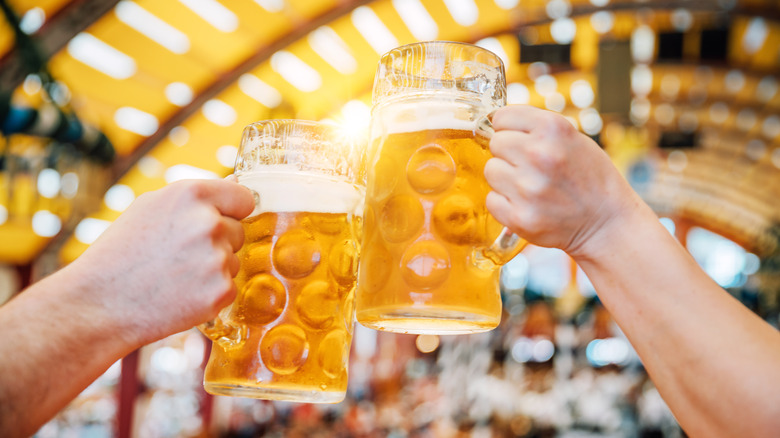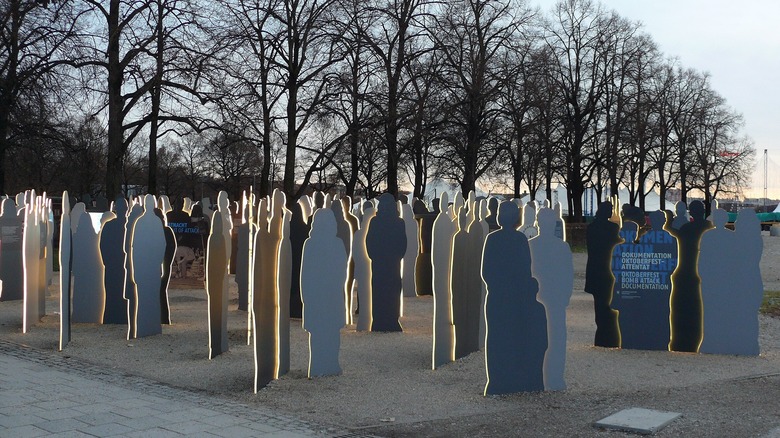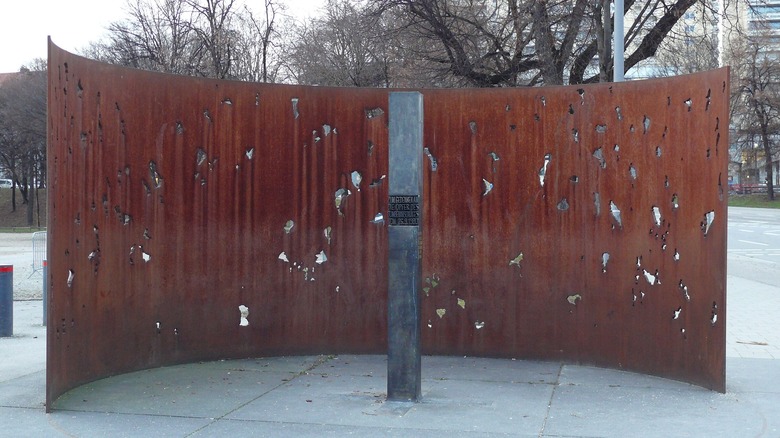The Tragic 1980 Bombing Of Oktoberfest
Oktoberfest: A time for rampant beer guzzling, wearing those funny German suspender things, doing some stupid dances, cheersing, chowing, and chatting. And if you're lucky enough to chance across a big Oktoberfest-ival in Germany itself, you might even find some roller coasters, carnival-style games, parades, an big open-air market full of vendors, some of that oompah-oompah Bavarian polka music, and more. But — grim facts incoming — the one thing you would never expect to find at such lively and fun proceedings is a bomb-based terrorist attack. Unfortunately for those in attendance at an Oktoberfest event in Munich in 1980, this is exactly what happened.
For 21-year-old student Gundolf Köhler it was simply a matter of tossing a bomb into a garbage can at Theresienwiese plaza and watching it go off in the crowd. As Deutsche Welle explains, this is exactly what Köhler did before the explosion injured over 200 people and killed 13 — including himself. Whether or not he intended to die along with his creation is unknown. Köhler's attack was one of the worst terrorist attacks on German soil since World War II, happening a full nine years before east and west Germany reunited when the Berlin wall fell in 1989. Even so, Deutsche Welle says that authorities at the time didn't attribute political motivations to his actions but rather "depression, relationship problems, and exam stress." Nearly 40 years later, though, it seems that Köhler had ties to far-right extremists.
Ties to far-right extremist groups
Gundolf Köhler's case remained closed until 2014 — 34 years later — when authorities decided to reopen it after a witness stepped forward to talk about the attack. Per The Washington Post, prosecutors said the witness suggested the 21-year-old had "co-conspirators" with whom he'd worked when he bombed Theresienwiese during Oktoberfest in Munich in 1980. They also said it was clear Köhler "had been motivated by far-right extremism" rather than simple young adult angst.
Prosecutors found Köhler had undergone military training with the neo-Nazi paramilitary organization Wehrsportgruppe Hoffmann, a group which The Washington Post says was just one of "several dozen other" such groups lurking in West Germany at the time. He also had a very telltale poster of Adolf Hitler above his bed. And yet, as Tagesspiegel quoted authorities at the time (via Deutsche Welle), "There weren't sufficient indications [at the time] for the involvement of other people either as accomplices, instigators or helpers." According to Deutsche Welle, such conclusions have drawn the ire of those who accuse German authorities of "downplaying the danger posed by far-right extremist" in the country.
For his part, Bavarian president Frank-Walter Steinmeier seemingly shares these sentiments. At a 2020 memorial event marking the 40-year anniversary of Köhler's attack he said that individuals like Köhler didn't act in a bubble, but were part of "networks that we need to investigate," per The Washington Post. In an acknowledgement of Germany's difficult past, he also admitted that "right-wing extremism has deep roots in our society."
[Featured image by Martinus KE via Wikimedia Commons | Cropped and scaled | CC BY-SA 4.0]
A memorialized, unresolved case
Authorities closed the investigation into the 1980 Munich Oktoberfest bombings in 2019, five years after the investigation had been reopened in 2014. As openDemocracy says, there were no concrete developments beyond the aforementioned witness coming forward, so the entire thing was laid to rest again. Despite learning about bomber Gundolf Köhler's far-right-leaning inclinations, the outlet said that "the motivation for this bombing remains as yet an unresolved question." It's possible that the attack was merely meant to provoke and exacerbate political tensions. 1980 was an election year in Germany, and a time when "internal security" and terrorism were common topics of concern. That being said, there's no way to be certain, and interested parties are left with speculation, deductions, and assumptions.
At present, there's a memorial at the site of the attack that's stood since 1981. As Oktoberfest.de says, there's a pillar engraved with the names of the victims of the attack, as well 200 eerie, life-sized silhouettes of people arrayed in the area. The site is fully accessible and open to the public. There's also a host of video clips and relevant information on-site available for watching, including interviews with witnesses. "I pay the greatest respect to the dedicated survivors for sharing their experiences with the public," Cultural Affairs Officer Anton Biebl said of the interviews. "Their haunting voices are a reminder. We must take better care of victims of right-wing violence, prosecute the crimes, educate comprehensively and remain vigilant."
[Featured image by Martinus KE via Wikimedia Commons | Cropped and scaled | CC BY-SA 4.0]


